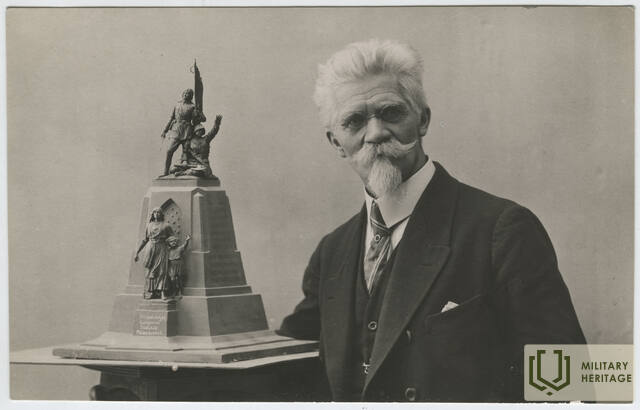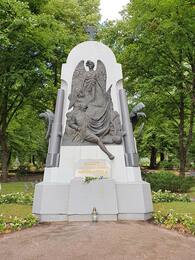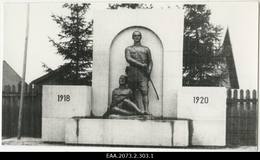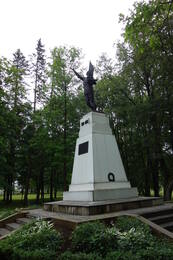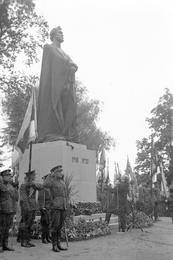Amandus Adamson (1855-1929) I Wars of Independence
Estonian sculptor, academician and one of the founders of Estonian national art.
Amandus Heinrich Adamson was born on 12 November 1835 on Pakri Peninsula. His artistic gift was discovered early, he supposedly carved his first wooden figure for his brother before learning to read.
Despite his humble background and multiple failed attempts at enrolling, Adamson managed to enrol in Saint Petersburg Academy of Arts in 1876 as a visiting student, graduating in 1879 with a silver medal. He went on to become a freelance artist in Saint Petersburg and soon began receiving commissions from the aristocracy and even the sovereign's family. On 8 April 1887, he opened his first solo exhibition in Saint Petersburg. Adamson lived in Paris from 1887 to 1891, which was an artistically productive period during which he developed his style. In 1889, he entered two of his works in the Exposition Universelle in Paris and won an award.
In 1901, Adamson turned to designing monumental sculptures. His first commission was the Monument to the Sinking of the Russian Warship Russalka in Tallinn (1902) – the Estonian sculptor's first monument in Estonia.
In 1907, Adamson was made academician of Saint Petersburg Academy of Arts and tutored many, among whom were famous Estonian artists Nikolai Triik and Konrad Mägi.
In the outbreak of the Russian Revolution, Adamson returned to Estonia and settled in the town of Paldiski, later he lived and worked in Italy from time to time.
His works are in the style of Neo-Baroque with Realist influences and are often allegoric. He has designed many War of Independence monuments (in Pärnu, Valga, Rakvere, Narva-Jõesuu, Viljandi, Suure-Jaani, Kuressaare, the statue of Kalevipoeg in Tartu by Emajõgi River).
Adamson died on 26 June 1929 at his home in Paldiski. He is buried next to his designed Monument to the War of Independence in Pärnu. The Adamson family gave the artist's summer studio house in Paldiski to the Estonian government in 2005. The Amandus Adamson Studio Museum was opened there as a branch of Harjumaa Museum in 2010.
Related objects
War of Independence Monument in Pärnu
This monument was designed by Amandus Adamson. It was unveiled in Alevi cemetery in Pärnu on 16 July 1922. Its designer was buried next to it in 1929.
On 15 April 1945 the monument was blown to pieces, which were then buried. The statue of a boy with a garland was buried by local high school girls 175 metres from the monument. Luckily the graves of the soldiers were left untouched.
The garrison cemetery was renovated in 1987 and the parts of the monument (incl. statue of the boy with the garland) were dug up in 1988. On 24 February 1989 the upper part of the monument, which was found buried in its original location, was unveiled with a granite tablet reading: "1918 1920 / HERE WAS UNVEILED, ON 16 JULY 1922 THE MONUMENT TO THOSE / FALLEN IN THE WAR OF INDEPENDENCE / SCULPTOR AMANDUS ADAMSON / DESTROYED IN 1945 / 24 II 1989 P.M.S." The full restoration of the monument and cemetery was completed in stages. The monument was unveiled anew on 17 July 1993.
Monument to the War of Independence in St Paul's Cemetery
This monument is situated in the north corner of St Paul's Cemetery in Tartu.
Designed by sculptor Aleksander Eller and city architect Arnold Matteus, it depicts two soldiers fashioned by Amandus Adamson and was unveiled on 11 November 1934. During the Soviet occupation the sculptures and dates were removed from the monument. On 10 October 2015 a War of Independence memorial was unveiled in the same location, comprising the sculpture ‘Kalev and Linda’ by Mati Karmin and a ceremonial square designed by Mati Karmin and Tiit Trummal with pathways, park benches and directional lights. The monument marks the mass grave of 254 soldiers who died in the War of Independence.
Monument to the War of Independence in Valga
This monument, in remembrance of freedom fighters from Southern Estonia, depicts a statue of an unknown soldier, his sword sheathed, holding a flag in one hand and the other outstretched, standing on top of a tall plinth. The original monument was unveiled on the 31st birthday of Lieutenant Julius Kuperjanov on 11 October 1925, but was demolished by the Soviet regime on the night of 21 September 1940. It was unveiled anew at its original location on Kuperjanovi Street in Valga on 16 August 2013. The original monument was designed in 1925 by Amandus Adamson, who also oversaw the bronze sculpture's casting in Italy. It was restored to its full size by sculptor Jaak Soans. The restoration was organised by the non-profit organisation VIKP (Permanent Exhibition of Patriotic Education in Valga), the town and county government of Valga and the Estonian War Museum.
Monument to the War of Independence in Tartu
This monument is situated on the right-hand bank of the Emajõgi River by Vabaduse Avenue (between the Vabaduse and Kaarsilla bridges) in Tartu.
Designed by Amandus Adamson, it was unveiled on 17 September 1933 and featured a cast-bronze sculpture of the Estonian epic hero Kalevipoeg leaning on his sword. The monument was removed in 1950, but as people continued to bring flowers and candles to the site, a bust of writer Friedrich Reinhold Kreutzwald was unveiled there in 1952. The restored monument, fashioned by sculptor Ekke Väli based on old photos, was unveiled on 22 June 2003.




